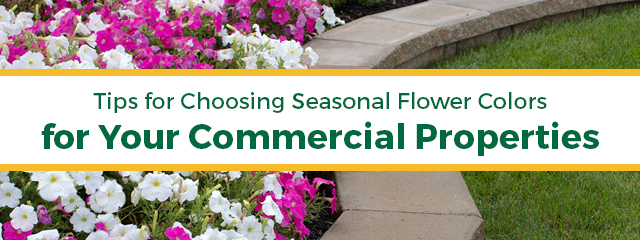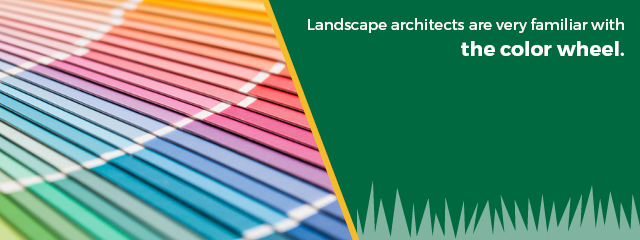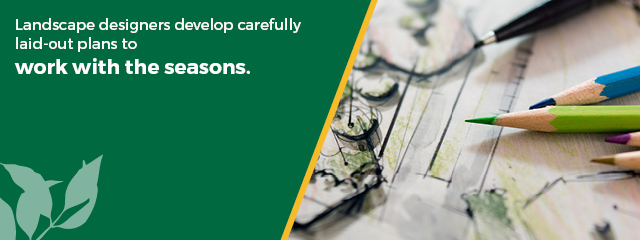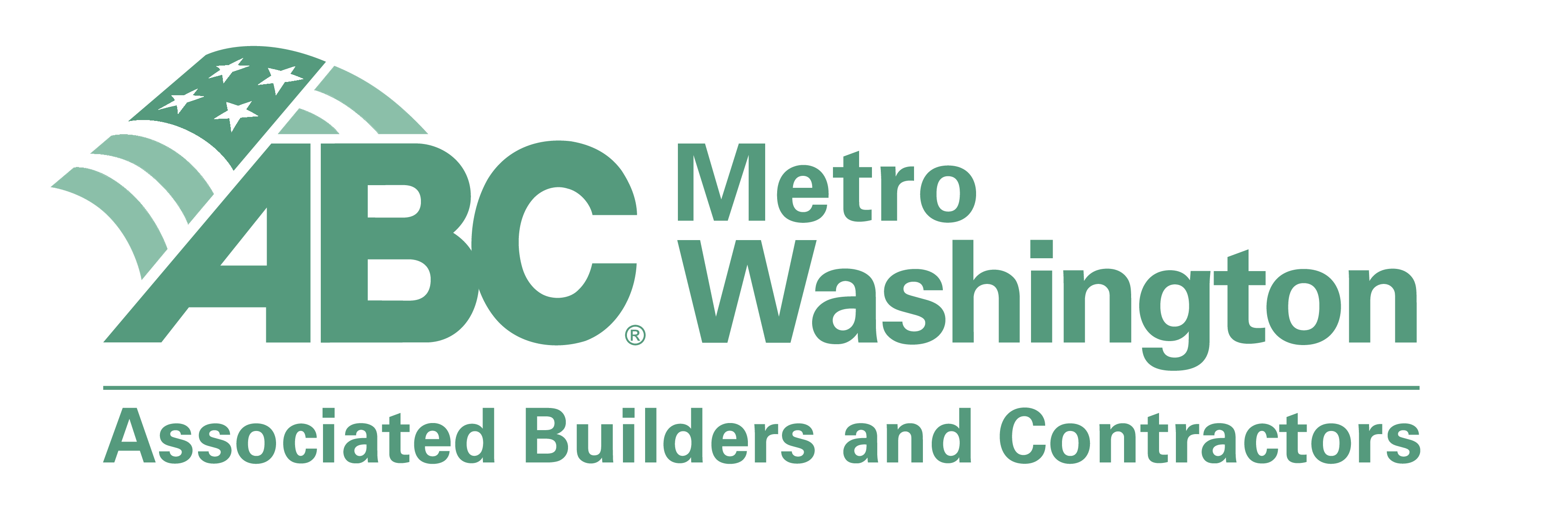Tips for Choosing Seasonal Flower Colors for Your Commercial Properties

They say there’s only one chance to make a first impression. That’s eternally true, particularly for a good impression. Making a lasting impression is even more important. It’s especially applicable if you own commercial property where positively influencing occupants, visitors and customers through landscaping design is crucial to your business. One of the best and most economical returns on your landscape investment is choosing the right seasonal flower colors.
There’s a strong relationship between commercial flowers and property value. Colors have a remarkable influence on human emotions. It’s no coincidence fast-food outlets use invigorating shades of red, orange and yellow. Medical facilities, on the other hand, use soothing hues of blues and greens. And institutions all use bland blends of beige and gray for a neutral effect. Properly choosing commercial planting colors has the same effect on property value.
No doubt your building architect put a lot of thought into your exterior and interior colors. Color selection is core to design principles and determines a valuable environment as much as the physical products do. That principle applies to your landscape architecture as well, where commercial plantings and property value go hand-in-hand. What colors you select will have an impact on your client base, regardless of whether they realize it or not.
While building façades and interior wall colors are generally static, your exterior flowers don’t have to be. You can easily change and rotate floral color schemes as the seasons pass. Spring calls for signs of new growth. Summer requires brilliant splashes of color that respond to long days and high temperatures. Fall, on the other hand, shows changing times and slowing down. And winter, although dormant, still carries color reflective of the cold season.
Color Selection Principles for Flowers
When choosing commercial flower colors, keep in mind they should be a reflection of your values. No one would argue against having a beautiful show of flowers surrounding your entrance, walks and yards. Customers will be more inclined to drop in. Visitors stay longer and leave with the seed of prosperity planted. And tenants appreciate their flowered surroundings, making them more inclined to care for your property.
Landscape design and maintenance professionals know effective color selection is a founding principle of getting the most from property performance and value. The right flower color selection elicits powerful emotional responses from people. That’s how nature has wired its inhabitants. Just as flower colors influence birds and insects, we humans also respond to properly selected and placed commercial plantings.
Although flowers play a central role in attracting people’s eyes, they also work with backdrops in your landscaping. Flowers are the showpieces in your property, and they work in harmony with foliage, bark, soil, stone and grass. Flowers also harmonize with hardscapes like walks, building sides, retaining walls, fences and even outdoor artwork. Regardless whether it’s a basket of brilliant flowers or a background of wood, the cumulative effect is all about color.

Using the Color Wheel to Select Seasonal Flowers
Landscape architects are very familiar with the color wheel. You’ve probably heard about this simple device that sets out primary and secondary colors. If you haven’t, it’s best to think of a box of crayons set out in a circle. These are the basics you’ll find on a six-part color wheel, and you’ll also find them in your commercial flower selection.
- Primary colors: Red, yellow and blue are the primary colors. They’re the basic light refractions that aren’t divided into subgroups. Primary colors don’t touch each other as pie shapes on the wheel. Rather, they contrast each other and work with secondary colors to form every shade in the floral rainbow.
- Secondary colors: Orange, green and violet are the secondary colors. These also sit across from each other on the color wheel, and they touch the primaries. Think of the secondary colors as byproducts of the primary colors. For instance, when you mix yellow and red, you get orange. Mixing red and blue gets you violet. Or, if you combine blue with yellow, you’ll get green.
This sounds very elementary, and it is. But there’s a lot more to know about color selection principles and how they affect your seasonal flower plantings. Drilling deeper into the color spectrum, here are some more terms commercial landscapers rely on to build the best seasonal showpieces.
- Hues: Essentially, all colors are hues. That goes for the primary colors, secondary colors and every color you can possibly blend. Blending hues on the color wheel extends from the basics and works on a triad where you mix a primary with two secondary colors or vice versa.
- Warm colors: Think of the sun, and you’ll get the idea of warm colors. Yellow, orange and red are warm colors. They reflect heat and fire, making them exciting and vibrant.
- Cool colors: Green, blue and violet are cool colors. You may associate them with the sky, forest and water. Cool colors soothe and relax, extending a calm and pastoral effect.
- Bright colors: Both warm and cool hues can seem bright and alive. Brightness reflects a color’s intensity. Two bright colors amplify each other when used together, and it’s a landscaping principle used mostly in the spring and summer.
- Soft colors: Soft colors ease the eyes and give a passive, reflective experience. Commercial landscapers often use one soft color with an adjacent bright color in midsummer, then tone the hues to two soft colors for the fall when days shorten and temperatures drop.
- Value: This term is the ratio of color brightness to softness. On the color wheel, black is the absence of all colors, and white is the presence of all colors. Mixing black and white makes gray, and it’s a color medium often used to adjust soft and bright hues.
- Intensity: This word also refers to brightness. It’s a core element of flower selection where landscapers use intensely bright colors beside each other for a dramatic statement, such as during midsummer. Conversely, professional gardeners use less intense flowers to introduce spring slowly or let fall depart gradually.

Developing Seasonal Flower Color Schemes
If you stop for a moment and visualize a dramatic seasonal flower planting, you’ll probably notice the landscape designer intentionally evoked a color scheme. That experienced floral planner didn’t just throw a bunch of annuals and perennials in with some shrubs and manage to dazzle your gaze. They took time to develop the arrangement thoroughly to work with the season.
That landscape designer knew what flower colors to plant when and where. This carefully laid-out arrangement followed a purposeful plan or a design theme. In the commercial landscape business, this forethought is called building a color scheme. Your designer worked within six standard flower arrangement schemes and did their best to evoke a different psychological response with each one. Let’s look at what the six color schemes are.
- Monochromatic: Monochromatic, or mono, means using flowers from the same hue range with only slight variations in intensity and value. Monochromatic flower plantings have a harmonious visual effect. Often, they’re in a warm shade, like a sea of yellow marigolds for the summer. Or your landscaper could plant a bed of cool, monochromatic white alyssum for early spring or late fall.
- Analogous: This seasonal color plan uses colors beside each other on the wheel. For instance, violet and red are analogous to each other. They blend, rather than contrasting. Envision a mid-summer salvia display with red and violet spikes sitting in a mass planting. Or you can have an early spring tulip mix of yellow and orange.
- Complementary: Complementary seasonal flower plans use opposite colors. Each color contrasts the other, but nature has an amazing ability to let opposites attract and complement each other. Purple and yellow are opposites on the wheel. They give an awesome effect such as in a fall planting where you use these two dahlia colors together.
- Primary: Flower planting schemes using primary colors have an incredible effect in midsummer, when sun intensity peaks and daylight stays long. Your landscaper might set out a primary color display of vivid yellow, red and blue petunias. This proven combination is great when planted close to entrances where primary colors have an attracting influence. It makes the doorway seem closer.
- Riotous: Here’s where your landscape designer threw away the rulebook and used flowers from every part of the color wheel. You’ll often see this in hanging baskets where nothing looks out of place. Riotous baskets run right from late spring to late fall. Some with hardy geraniums last well into winter.
- Pastel: Pastel flower plantings give a cool and distant feeling. Landscapers often use pastels, or lighter-hued plants, for early starts just when the ground temperature allows growth. The same goes for when frosty night air ends most annual shows, but pastel foliage stays on as long as it can. Good examples of pastels are the delicate greens of flowering cabbage and kale. You’ll also see pastel schemes in low-light areas where pink impatiens and light yellow begonias thrive.

Using Seasonal Flower Colors With Anchor Plantings
Professional landscape designers look at your property in its entirety. They see the big picture and envision how your investment will show best through every season. That includes spring when new growth starts, summer when flowers are at their brightest, fall when colors naturally turn to subdued hues and winter when dormancy hits, but anchor plantings remain highly visible.
Anchor plantings are your permanent pieces that stay in place year-round. Trees and hedges are prominent anchor plantings. So are flowering shrubs, perennials and ground cover. When laying out a professional landscape plan, the architect carefully considers how your annual flowers rotate through the seasons and perfectly complement those permanent residents.
For the most part, seasonal flower plantings refer to annuals. Those are bedding plants that sprout in the spring or early summer and then bloom for a relatively short period before going to seed and dying off. Although annuals are not long-lasting, they more than make up for longevity with a show.
Work this to your advantage by using seasonal flower colors with your anchor plants. Your landscaper pays particular attention to seasonal flower placement. That means they place annuals in spots that work with anchor plants. It’s not just to complement or contrast existing anchors that give intense foliage colors or flowers of their own.
Seasonal Flowers and Sun Exposure
Proper plant placement or seasonal show depends on two factors. One is the particular annual species. The other is the amount of light they require. For example, annuals requiring full sun won’t prosper in dark, shady areas. On the other hand, shade-loving annuals will burn in bright conditions. Here are a few seasonal flower color and placement suggestions for your commercial property.
- Full sun: In North America, full sun usually means south and west exposures. If your property’s façade faces into the sun, you can make a dramatic color statement by placing full-sun annuals at your entrance. Think of a contrasting combination of purple heart with white alyssum or orange cosmos inside a band of blue lobelia.
- Partial sun: East-facing spots that get sun from daybreak to noon let certain plants put on their best. This also works with limited noon sun, where anchor plants cast shadows or late afternoon exposure on west lines. Part-sun performers are begonias, snapdragons, bacopa andageratum. With these annuals, you can mix and match to your heart’s content.
- Partial shade: Partial shade isn’t quite the same as partial sun. It refers to light shade most of the day where direct sunlight filters through your anchors. Great partial-shade seasonal flowers are pansies in the spring, fuschia in the summer and Persian shield come fall. In the winter, you’ll do nicely with ornamental cabbage and even early lettuce.
- Full shade: Every commercial property has some spots that don’t receive direct sunlight. But don’t worry. There are flowering seasonals that work well out of the sun. Check out coleus, caladium, torentia fourieri and hypoestestes phyllostachya, or what’s called the polka-dot plant. They might not be brightly colored, but they’re still fun.

Work With a Commercial Landscape Design and Maintenance Professional
Putting together a winning seasonal flower show that’s full of color for as long as nature allows is fun. It can be even more enjoyable when you work with commercial landscape design and maintenance professionals. You’ll love it, and so will your tenants, customers and visitors.
Complete Landscaping Service is your commercial full-service professional for the Maryland, D.C. and Northern Virginia region. By complete, we mean just that. We give you full-service landscape design, construction, planting and maintenance service year-round. That goes for original and unique designs, seasonal flower color planting, regular maintenance and even winter snow management.
Complete Landscaping Service has nearly 40 years of experience in designing commercial landscape plans for commercial properties. Our professional team knows what plants thrive in the Maryland, D.C. and Virginia climatic zone. We know what flowering annuals give you the best return and precisely what season they do best.
Whether it’s spring, summer, fall or winter, Complete Landscape Service makes sure your commercial planting colors and property value are complementary. We work with owners of commercial buildings, apartment communities, retail buildings, offices, hospitals, clinics and more. Talk to one of our commercial landscape experts today to find the perfect color arrangement for your commercial property’s seasonal flowers.






